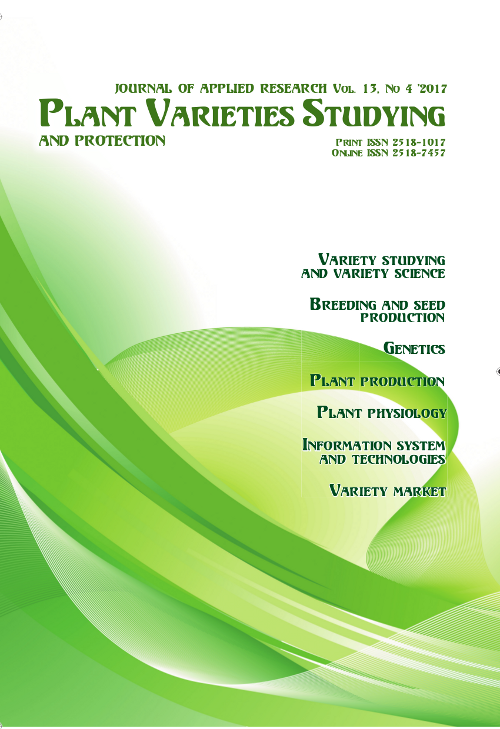Peculiarities in covering the requirements for seed material of sorghum crops
DOI:
https://doi.org/10.21498/2518-1017.13.4.2017.117754Keywords:
great millet, varieties and hybrids, yielding, seeds, planting acreageAbstract
Purpose. To assess the demand for sorghum seed material and sufficiency of domestic seeds.
Results. The analysis of the State register for the period of 2002–2012 showed that there was the tendency not only towards increasing quantity of sorghum crops in general but their substitution by hybrids of foreign breeding. During the period from 2002 to 2017, 72 sorghum varieties were entered on the State register in total, among them only 12 varieties were of domestic breeding, the rest 60 was presented by foreign breeding institutions. Investigation results allowed to determine that the production of base and prebase seeds of sorghum in 2010 amounted to 1,3 t, in 2016 was 43 t. During the same period the production of sugar sorghum increased from 0,2 to 12,0 t, grass sorghum – from 4,0 to 83 t. In 2017, requirements of acreage of such crops as grass sorghum and broomcorn were completely satisfied by the amount of grown seeds. At the same time, the need for seeds of sorghum and sugar sorghum can not be covered completely at the expense of domestic varieties reproduction. In 2017, general demand for sorghum seeds was 400,5 t, among which only 42,0 t was of domestic production. The rest demand for seeds will be met at the expense of import of foreign breeding seeds into the country to be grown and prepared for sowing abroad.
Conclusions. In the Register of plant varieties suitable for dissemination in Ukraine, there are 72 sorghum varieties among them only 12 varieties were of domestic breeding, that is 17%, as compared to 83% of recommended great sorghum varieties of foreign breeding. In Ukraine, the area occupied by sorghum cultivation was 22,8 thou ha in 2005, up to 2017 it increased to 89,0 thou ha, and accordingly the demand for seeds run up from 102,6 to 400,5 t. The area occupied by the sugar sorghum in 2005 amounted to only 2,6 thou ha, in 2017 – 20,0 thou ha, that accordingly determined increase of demand for seed material from 13,0 to 99,9 t. In 2017, the part of the area where domestic hybrids of sorghum are growing was 10%, hybrids of sugar sorghum – 12%, that was indicative of very poor situation with domestic varieties dissemination.
Downloads
References
Derzhavnyi reiestr sortiv roslyn, prydatnykh dlia poshyrennia v Ukraini na 2017 rik [State register of plant varieties suitable for dissemination in Ukraine in 2017]. (2017). Retrieved from http://minagro.gov.ua/uk/ministry?nid=21767 [in Ukrainian]
Derzhavnyi reiestr vyrobnykiv nasinnia i sadyvnoho materialu [State register of seeds and seedlings producers]. (2017). Retrieved from http://dpcenter.org.ua/reyestri/ [in Ukrainian]
Roslynnytstvo 1990–2016 [Plant production 1990–2016]. Retrieved from http://www.ukrstat.gov.ua [in Ukrainian]
Storozhyk, L. I. (2016). Ahrobiolohichni osnovy formuvannia ahrofitotsenoziv sorho tsukrovoho yak bioenerhetychnoi kultury v Stepu ta Lisostepu Ukrainy [Agrobiological basis for the development of agrophytocenoses of sugar sorghum as bioenergy crop in the Steppe and Forest-Steppe zones of Ukraine] (Extended Abstract of Dr. Agric. Sci. Diss.). National Scientific Centre «Institute of Agriculture NAAS of Ukraine», Kyiv, Ukraine. [in Ukrainian]
Cherenkov, A. V., Shevchenko, M. S., Dziubetskyi, B. V., Cherchel, V. Yu., Bodenko, N. A., Yalanskyi, O. V., … Benda, R. V. (2011). Sorhovi kultury: tekhnolohiia, vykorystannia, hibrydy ta sorty [Sorghum crops: technology, use, hybrids and varieties]. Dnipropetrovsk: Roial Prynt. [in Ukrainian]
Downloads
Published
How to Cite
Issue
Section
License
Copyright (c) 2017 Ukrainian Institute for Plant Variety Examination

This work is licensed under a Creative Commons Attribution-ShareAlike 4.0 International License.
Starting in 2022, the copyright to the publication remains with the authors
Our journal abides by the CREATIVE COMMONS copyright rights and permissions for open access journals.
Authors, who are published in this journal, agree to the following conditions:
- The authors reserve the right to authorship of the work and pass the first publication right of this work to the journal under the terms of a Creative Commons Attribution License, which allows others to freely distribute the published research with the obligatory reference to the authors of the original work and the first publication of the work in this journal.
- The authors have the right to conclude separate supplement agreements that relate to non-exclusive work distribution in the form in which it has been published by the journal (for example, to upload the work to the online storage of the journal or publish it as part of a monograph), provided that the reference to the first publication of the work in this journal is included.

























 Ukrainian Institute for Plant Varieties Examination
Ukrainian Institute for Plant Varieties Examination  Селекційно-генетичний інститут
Селекційно-генетичний інститут Institute of Plant Physiology and Genetics of the National Academy of Sciences of Ukraine
Institute of Plant Physiology and Genetics of the National Academy of Sciences of Ukraine
 The National Academy of Agrarian Sciences of Ukraine
The National Academy of Agrarian Sciences of Ukraine